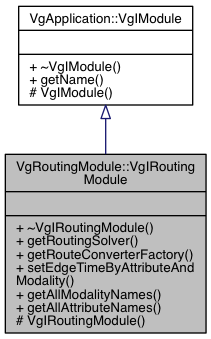VgIRoutingModule provides access to routing related objects
| VgRoutingModule::VgIRoutingModule::VgIRoutingModule |
( |
| ) |
|
|
inlineprotected |
| virtual VgRoutingModule::VgIRoutingModule::~VgIRoutingModule |
( |
| ) |
|
|
inlinevirtual |
| virtual void VgRoutingModule::VgIRoutingModule::getAllAttributeNames |
( |
std::vector< std::string > & |
pNames | ) |
const |
|
pure virtual |
This method is used to get the names of all the attributes present in the database. Within the database, each routing node may have zero or more attributes associated with it. An example of a attributes might be "stairs" or "lift" and represents a physical medium. Currently, attribute are used to indicate floor transition types.
- Parameters
-
| pNames | The list of strings that will be fed with the attribute names. This may return an empty vector if no attributes are specified within the database. |
- Version
- 2.0.7729
Referenced by ~VgIRoutingModule().
| virtual void VgRoutingModule::VgIRoutingModule::getAllModalityNames |
( |
std::vector< std::string > & |
pNames | ) |
const |
|
pure virtual |
This method is used to get the names of all the modalities present in the database. Within the database, each routing edge may have zero or more modalities associated with it. An example of a modality might be "pedestrian" or "shuttle" and represents a method of movement.
- Parameters
-
| pNames | The list of strings that will be fed with the modality names. This may return an empty vector if no modalities are specified within the database. |
- Version
- 2.0.7729
Referenced by ~VgIRoutingModule().
| virtual VgIRoutingSolver* VgRoutingModule::VgIRoutingModule::getRoutingSolver |
( |
| ) |
|
|
pure virtual |
| virtual int VgRoutingModule::VgIRoutingModule::setEdgeTimeByAttributeAndModality |
( |
const std::string & |
pEdgeAttribute, |
|
|
const std::string & |
pModality, |
|
|
float |
pTime |
|
) |
| |
|
pure virtual |
Sets the traversal time for a given modality on edges with a given attribute.
- Parameters
-
| pEdgeAttribute | The searched attributes. All edges containing this attribute will be affected. |
| pModality | The affected modality (time can only be set for modalities, no time concept in edges alone). |
| pTime | The time to associate (should be positive) |
- Returns
- The number of edges that were affected.
- Version
- 2.0.7729
Referenced by ~VgIRoutingModule().
The documentation for this class was generated from the following file:

 Public Member Functions inherited from VgApplication::VgIModule
Public Member Functions inherited from VgApplication::VgIModule Protected Member Functions inherited from VgApplication::VgIModule
Protected Member Functions inherited from VgApplication::VgIModule